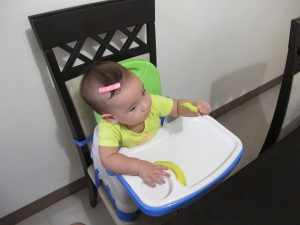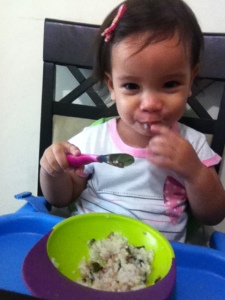It can be very frustrating when your baby refuses to eat anything, even his most favorite food at that.
From the beginning, we have followed the principles of Baby-Led Weaning also known as Baby-Led Feeding. This is a method wherein you do not puree or mash foods and/or spoon-feed, once the baby is ready to start eating solids (6 months and up). In Baby-led Weaning, you will offer the food in a way they can easily grab, instead.
What is Baby-Led Weaning?
Baby Led-Weaning or Baby-Led Feeding is simply Self-Feeding. This concept will allow your child to learn to chew before swallowing. Chewing is very important because this is a precursor to talking and exercising those muscles is extremely necessary for it. Learning how to chew also eliminates the difficulty when you transition to “real” food. Most kids I know resist eating real food if they are used to mashed food. Why? Because it is so much easier to swallow than to chew and allowing your child to go on with this can be a cause for greater problem, later.
What are the signs of readiness?
1. When the baby is able sit on his own – unsupported.
2. When the baby can accurately grab something and put it in their mouth.
3. When baby starts making chewing and gnawing movements.
The main reason why we chose this method for Matilda was because, we believe that if she learns to eat on her own at a very young age, she would most likely develop good eating habits as she grows.
In baby-led weaning, no special food or preparation is necessary. All you need is to invest on a highchair, and you are good to go. What’s so good about this is, what you will eat at home is what your child should eat as well (minus the salt for babies below 1 year old). Why? Well, why not? Would you want your children eating bottled/canned or processed unhealthy, junk food? Of, course not! So like them, you are forced to eat right. This worked for us a lot. Way back, we loved eating deli meat, processed food, and canned goods for breakfast, but since Matilda started eating, these became just emergency food or a “treat” for our family. We resorted to serving healthier options to encourage Matilda to do the same.
Baby-led weaning also relieves all the stress of feeding your child. Because Matilda is breastfed, there was never really pressure on my part about her eating. At 6-12 months, breast milk is still her main source of nutrition and food is just for fun. Whether she eats or not, it was fine. When she hit a year old, she still wasn’t eating very much but I just waited patiently for her to be more interested. (It takes quite an amount of patience, mind you, but do believe me when I say, it will pay off later!)
We started out by giving her a variety of fruits and vegetables like that of avocado, sweet potato, squash, banana, apple, carrots, and a lot more which I prepared either fresh – for fruits or steamed, roasted, or sauteed in olive oil or unsalted butter for the vegetables. I gave her these in finger-sized portions which she can easily grab and munch on.
Gagging vs. Choking
Here’s the deal, I strongly believe that no matter how you decide to feed your child, you must be equipped in knowing how to handle these incidents. Yes, it is true that choking is possible, but the possibility is never greater compared to those who are fed traditionally. Remember when you spoon-feed mashed food, the baby is used to swallowing rather than chewing, right? So when you start introducing lumpy food, that’s where the problem usually starts. If you think about it, in baby-led weaning, since the baby learns to chew before swallowing, he becomes a lot more careful about the food he will put in his mouth. I know this for a fact because I have witnessed this with Matilda. She did have gagging episodes during the early days of baby led weaning, but she did outgrew it eventually. So, how do you distinguish gagging from choking then?
Gagging is a baby’s natural and normal reflex when the food is too big for him to swallow. The gag response for babies is much more active than that of adults because it is triggered far forward on the tongue. As the baby grows, it moves farther back, closer to the throat, that is why it is necessary for them to be able to manage food by themselves right from the very beginning. When they are aware of the size of the food they put in their mouth, it reduces the risk of choking as they already have practiced how much food they can handle.
You will know your baby is gagging when he starts making sounds as if he wants to vomit (naduduwal or nasusuka is the filipino term for it). They also sometimes cough and then spit the food out. In choking, however, baby becomes very quiet, almost gasping for air because the food lodged in his throat may have partially or totally blocked his airway and therefore, turns his color into blue.
So it is really good to know basic first aid for any emergency situation and for all you know, food isn’t the only thing that can cause choking. A lot of things can, it’s still best to be prepared.
Looking back, the first weeks were fun although frustration was inevitable on my part when she won’t eat at all, I resolved to trusting her that she wasn’t hungry and was just at a phase of exploration. Soon enough, at about 9 months old, as I started introducing more and more food, she began showing more eagerness to try it out and began feeding herself a whole lot better. (I know this because I see it all in her poop! Haha!)
There will still be days, up until now when she wouldn’t eat or just grab a few bites and she’s done. And as I am able to observe her daily, I began realizing what causes these episodes and listed them down for your reference.
- Teething
- When she’s about to get sick with a cold or cough
- Right when she’s feeling ill
- At times when she’s just plain full or not hungry
- When she is allergic to the food
It is also good to know that since your child is eating food in its pure form, meaning you did not add any liquid to it, you must expect that he would most likely eat less than babies who are fed traditionally. Even though he just bit a few pieces, trust him that those few bites are just what his body actually needs.
Mealtimes should be fun and should always be about sharing the food with the whole family, the food that was provided by our Lord for our nourishment. Any negativity can be easily felt by your child so make sure you are calm and relaxed during this time. Also, try your best not to concern yourself over the mess your child will possibly create (no matter how OC you are – like me!) just let him be, and focus instead on the fact that your child is exploring and learning a lot by eating on his own. Baby-led weaning requires trust, trust between your baby’s own instinct and judgement as well as your trust on your child’s capability to do it by himself. So, when your child refuses to eat, don’t over-think it and just try again in the next meal. As time goes by, he will soon realize that food makes him feel full, and would then eat more and more each day.
Matilda is a living testimony why I encourage my friends to try Baby-Led Weaning. At 19 months, she eats a wide variety of foods from fruits to vegetables to fish to meat and has already mastered feeding herself with a spoon. I am just so happy I found out about this and I am glad I have virtual friends over at Baby-Led Weaning Philippines to support me in this journey.
To know more about baby-led weaning, please join the Facebook Group and try to grab a copy of the book as well.


